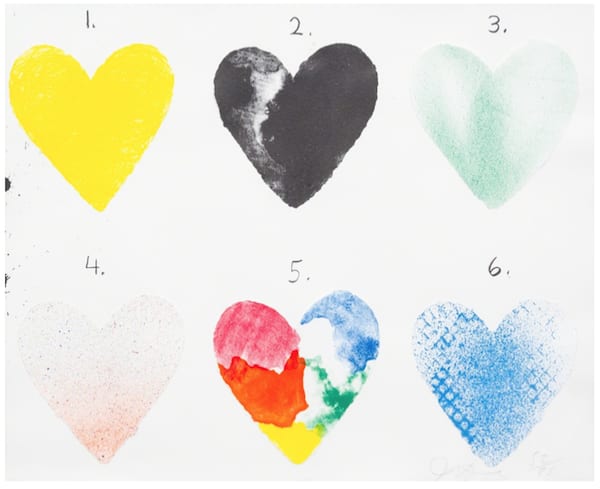Unlike many artists who produce editions, printmaking is a deliberate media choice for Jim Dine, enabling him tremendous freedom to explore, experiment and push the limits of the conventional wisdom of the process. Dine’s earliest recorded prints were the product of a ‘happening’, which he staged at Reuben Gallery in New York City in 1960. The Car Crash, 1960 focused upon themes of human suffering, and consisted of five black and white and one color lithograph. In contrast to the oeuvre of recurring imagery that would follow, Dine would never repeat this dark gestural, expressionist imagery again. However, these early editions unmistakably exhibit the veneration Dine holds for master etchers like Dürer, Rembrandt and Picasso. As seen in Four German Brushes (plate 3), 1973, the etching detail is sensitive and meticulous and the plate richly inked. Printmaking is unquestionably a collaborative affair in which Dine relishes. He has worked with virtually every master printer the world over, printing in every city he visits and printing nearly everyday. He even worked with Picasso’s illustrious master printer, Aldo Crommelynck. Crommelynck was famously appalled by some of Dine’s seemingly outlandish techniques—his use of electric tools and a complete disregard for accepted printmaking practices. But, both artist and master printer must work together, whether in a push-pull manner or a more harmonious union, the two must cooperate to execute the vision.
Dine embraces the randomness and accidental nature of the printmaking process. He never sketches prior to printing; all ideas go immediately onto the plate, contributing to the born-at-once quality of his prints. His editions are complex endeavors, often integrating multiple printmaking techniques into a single work. In Dream Venus, 2002 he combines soft-ground etching, lithography and hand stamping. Dine commonly uses electric tools such as jigsaws, chainsaws, dremels and drills. In the large-scale robe Very Picante, 1995 the segments of the robe were cut and composited from a large sheet of cardboard, and then reassembled on the press like a jigsaw puzzle. Fourteen jigsaw pieces were then relief printed in one print run, after which two more plates, cut by chainsaw, were printed. Dine also employs additive elements by hand coloring after printing such as acrylic paint, powdered pigments and watercolor. The integrated result is a dynamic, activated surface and a unique multifaceted composition.

